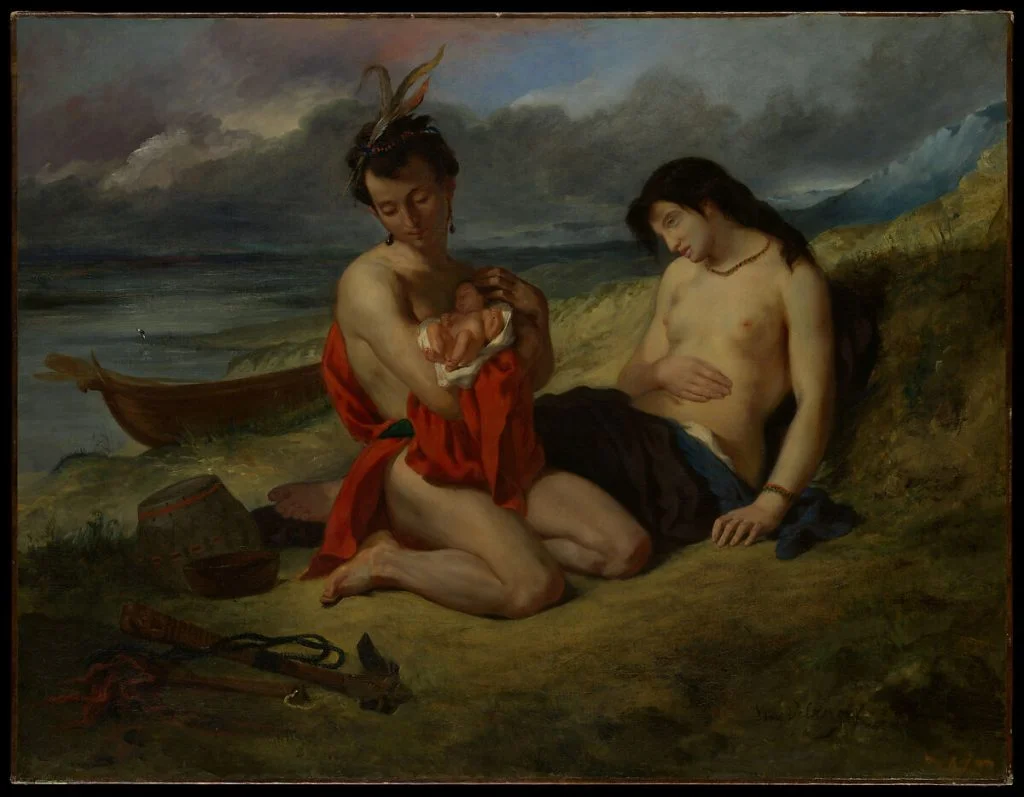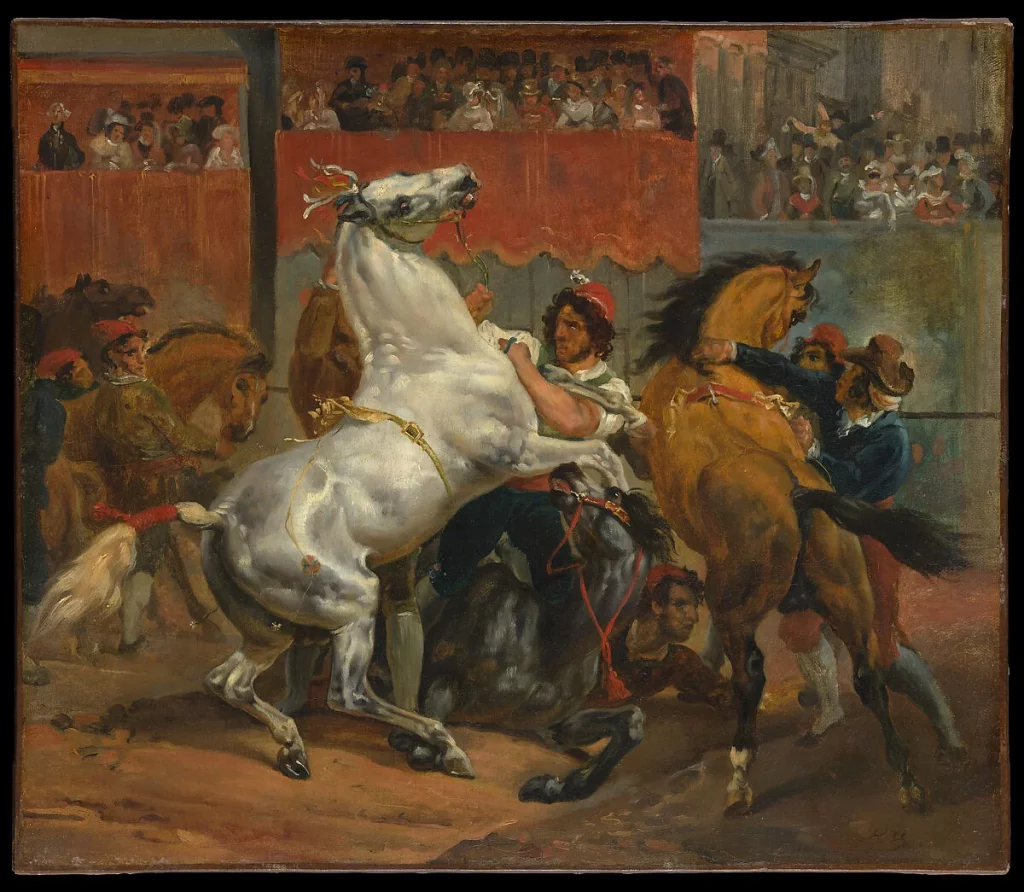Have you ever gazed at a stormy sky and felt an inexplicable urge to write poetry or paint a masterpiece? Welcome to the Romantic Era, a period when emotions ran wilder than a teenager’s first love affair!
From the dramatic landscapes of Caspar David Friedrich to the soul-stirring compositions of Beethoven, the Romantic Era was like a grand emotional rollercoaster – no safety belts, just pure, unbridled passion. So, buckle up (or don’t), as we dive into this whirlwind of emotions!
Invention, it must be humbly admitted, does not consist in creating out of void but out of chaos.
Mary Shelley
Romanticism Facts
Welcome to the realm of facts about the romantic era, where emotion and imagination reign supreme. Read carefully, as I created a quiz for you at the end of the article to test your knowledge on the topic.
- The Romantic Era typically refers to the period from the late 18th century to the mid-19th century.
- It was a reaction against the Industrial Revolution and the Age of Enlightenment‘s emphasis on reason.
- Emotion and individualism were highly valued in Romantic art, music, and literature.
- The movement began in Germany and quickly spread to other parts of Europe.
- Nature was a significant source of inspiration, often symbolizing the uncontrollable and sublime.
- William Wordsworth and Samuel Taylor Coleridge’s “Lyrical Ballads” (1798) is often considered the start of the English Romantic movement.
- Gothic literature, with its emphasis on emotion and the supernatural, was part of the Romantic movement.
- Nationalism influenced music and literature, as seen in the works of composers like Chopin and poets like Robert Burns.
- Romanticism often portrayed heroic individualists and rebels.
- Exoticism was also a theme, with an interest in cultures outside Europe, particularly the Middle East.
- Beethoven’s music, especially his later works, embodies the Romantic ideal of expressing personal emotion.
- The era saw the rise of the Byronic hero, a flawed but charismatic individual, inspired by the poet Lord Byron.
- Caspar David Friedrich is known for his landscapes that evoke emotion and the sublime.

- Imagination was considered more important than rational thought.
- Romantic poets often used spontaneous, everyday language in their work.
- Romanticism in America had a different flavor, often focusing on wilderness and the frontier.
- Transcendentalism, a philosophical movement in America, was influenced by Romantic ideals.
- John Keats, a prominent English Romantic poet, emphasized the beauty and transience of life.
- The Sturm und Drang (Storm and Stress) movement in German literature prefigured many Romantic ideas.
- Mary Shelley’s “Frankenstein” is a classic example of Romantic and Gothic literature.
- Romantic art often broke traditional composition rules to create drama and emotion.
- The Hudson River School was a significant American Romantic movement in painting.
- Escapism was a common theme, reflecting a desire to escape the industrialized world.
- Revolution and liberty were important themes, inspired by events like the French Revolution.
- Romanticism heavily influenced the development of later artistic movements like Impressionism.
- Schubert, Schumann, and Brahms were key composers of the Romantic music era.
- The era’s literature often explored the psychological and emotional states of characters.
- Eugène Delacroix was a leading figure in Romantic painting, known for expressive brushwork.

- Folk culture and traditions gained renewed interest and respect during this period.
- The concept of the “sublime” was central to Romantic aesthetics, often associated with awe-inspiring nature.
- Percy Bysshe Shelley and John Keats were part of the second generation of English Romantic poets.
- Romantic ballet emerged, focusing on themes of fantasy and supernatural elements.
- Walter Scott’s historical novels were immensely popular and reflected Romantic interests in the past.
- Romanticism in architecture saw the revival of Gothic and other medieval styles.
- George Gordon, Lord Byron, epitomized the Romantic hero and was as famous for his lifestyle as for his poetry.
- Emphasis on the individual led to a greater exploration of personal feelings and experiences.
- Watercolor painting gained popularity during the Romantic period for its ability to capture atmospheric effects.
- Victor Hugo in France was a major figure in Romantic literature, best known for works like “Les Misérables.”

- The Romantic era’s emphasis on emotion was a direct challenge to the Enlightenment’s emphasis on reason.
- Romantic nationalism helped shape the political map of Europe, influencing movements for independence and unification.
- Symbolism and allegory were frequently used in Romantic art and literature.
- Leo Tolstoy and Fyodor Dostoevsky in Russia were influenced by Romanticism, though they are often associated with Realism.
- The philosophy of Romanticism emphasized subjective experience and the uniqueness of each individual.
- Frederic Chopin’s piano compositions are exemplary of Romantic music’s emotional depth.
- Wanderer themes, expressing a sense of alienation and a search for meaning, were common in Romantic literature.
- The Romantic period saw a resurgence in Shakespeare’s popularity, partly due to his emotional depth and exploration of individual characters.
- Arthur Schopenhauer’s philosophy was influential in shaping Romantic ideas about art and aesthetics.
- The Grimm Brothers collected and published folk tales, reflecting the Romantic interest in traditional stories and culture.
- Romantic painters like Turner and Constable revolutionized landscape painting with their emphasis on light and color.
- Edgar Allan Poe in America contributed to the Romantic movement with his Gothic tales and poetry.
Romanticism Myths

Having explored all these facts, now it’s time to go a little deeper and uncover the truth behind some common myths about the romantic period.
- The Romantic Era Was Only About Love and Romance
The Romantic Era was more about emphasizing emotion, nature, and individualism than just love. It celebrated artistic freedom, the beauty of the natural world, and the depth of human emotion. - Romanticism Was a Unified Movement with a Single Style
Romanticism was diverse, with artists and writers exploring various themes and styles. It was not a single, unified movement but a collection of individual expressions and explorations of emotion and nature. - The Romantic Era Ignored Social and Political Issues
Many Romantic artists and writers were deeply involved in and influenced by the social and political events of their time. They often used their work to comment on and critique societal issues. - Romanticism Was Only a European Phenomenon
While it began in Europe, it quickly spread worldwide, influencing artists, writers, and thinkers across the globe. It had a significant impact on American literature and art as well. - The Romantic Era Valued Only Spontaneous, Unplanned Creation
While spontaneity and natural flow were valued, many Romantic artists and writers were meticulous in their work, often revising and refining their creations to capture their emotional and artistic visions.
No products found.
Romanticism Quotes

The Romantic era, which spanned from the late 18th to the mid-19th century, was a period marked by a focus on emotion, nature, individualism, and the sublime. Here are some of my favorite quotes that capture the essence of the Romantic era:
The Romantic Era is the sick era.
Johann Wolfgang von Goethe
Goethe, a leading figure in German literature, critically referred to the Romantic era as a time of excessive emotion and irrationality, highlighting the contrast with the rationalism of the Enlightenment.
Poetry is the spontaneous overflow of powerful feelings: it takes its origin from emotion recollected in tranquility.
William Wordsworth
Wordsworth, a central English Romantic poet, defines poetry as an expressive art form born from deep emotions, encapsulating the Romantic emphasis on personal feeling and nature.
The primary imagination I hold to be the living power and prime agent of all human perception.
Samuel Taylor Coleridge
Coleridge, another prominent English Romantic poet, emphasizes the importance of imagination as a powerful and fundamental human ability, central to the Romantic ideal of creativity and subjectivity.
I am such a strange mélange of good and evil that it would be difficult to describe me.
Lord Byron
Lord Byron, an influential British Romantic poet, reflects on the complexity of human nature, a common theme in Romantic literature that embraced the full spectrum of human experience.
Poets are the unacknowledged legislators of the world.
Percy Bysshe Shelley
Shelley, a major English Romantic poet, famously declared the profound influence of poets, asserting their role in shaping society and culture, a belief deeply rooted in the Romantic idealization of the artist.
Romanticism FAQ

We are leaving the quotes behind to continue with some common questions about that era. Read carefully, as this is the last section before the quiz. Don’t disappoint me.
- What is Romanticism in Art?
Romanticism in art refers to a movement that emerged in the late 18th century as a reaction against the Industrial Revolution and the rationalism of the Enlightenment. It emphasizes emotion, individualism, and the glorification of nature. Artists of this era sought to express intense emotions and highlight the sublime beauty and terror of nature, often through dramatic, moody, and imaginative artwork. - Who are Some Famous Romantic Artists and Their Works?
Some notable Romantic artists include J.M.W. Turner, known for his turbulent seascapes like “The Fighting Temeraire,” and Caspar David Friedrich, famous for his melancholic landscapes such as “Wanderer above the Sea of Fog.” Francisco Goya’s dark and dramatic scenes, like “The Third of May 1808,” also epitomize Romanticism’s focus on emotion and individual experience. - How Did Romanticism Influence Literature?
In literature, Romanticism brought a focus on emotion, nature, and individualism. Writers like William Wordsworth and Samuel Taylor Coleridge in England, and Johann Wolfgang von Goethe in Germany, emphasized personal feelings, imagination, and freedom from classical norms in their works. This era saw the rise of the novel and the lyrical poem as prominent forms of expression. - What Distinguishes Romantic Music?
Romantic music is characterized by its emotional intensity, expressive melodies, and dramatic contrasts. Composers like Ludwig van Beethoven, Franz Schubert, and Pyotr Ilyich Tchaikovsky pushed boundaries in harmony and form, creating music that aimed to evoke deep feelings and depict stories or landscapes. This period also saw the rise of the solo virtuoso, exemplified by figures like Niccolò Paganini. - How Did Romanticism Impact Society and Culture?
Romanticism significantly influenced society and culture by encouraging a shift towards individualism and emotional expression. It challenged the status quo and the Enlightenment’s emphasis on reason, leading to a greater appreciation for the arts, the natural world, and the depths of human emotion. This movement laid the groundwork for later artistic and cultural developments, including the rise of nationalism and the subsequent movements of Realism and Modernism.
No products found.
Romanticism Trivia

Welcome to the Romantic Era quiz! Where the only thing more tragic than a Byron poem is scoring zero – you might just find your tea turning into tasteless water!
Conclusion
As we close this journey through the Romantic era, a period rich in emotion, nature, and the depth of the human spirit, it’s essential to reflect on how these themes resonate with us today.
This era wasn’t just about artistic expression; it was a profound commentary on the human condition, a mirror reflecting our deepest desires and fears. It reminds us of the enduring power of creativity and emotion to shape our world.
How do you see the influence of the Romantic era in your own life and experiences? I’ll be happy to hear your thoughts in the comments.
5 Sources Used For This ArticleRomanticism And Its Influence On Our Own Era – Bartleby
13 Facts About Romanticism in Art – Art St
English Romanticism – Massimilianobadiali
Niccolo Paganini And The Romantic Movement – Slideshare


